stop start CHEVROLET SSR 2003 1.G Owner's Manual
[x] Cancel search | Manufacturer: CHEVROLET, Model Year: 2003, Model line: SSR, Model: CHEVROLET SSR 2003 1.GPages: 374, PDF Size: 2.55 MB
Page 233 of 374
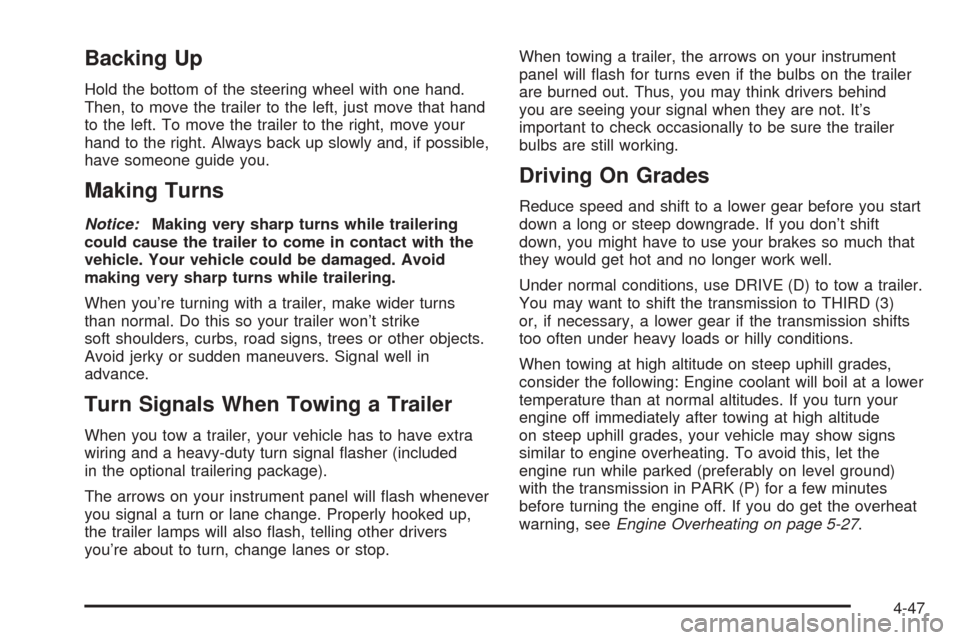
Backing Up
Hold the bottom of the steering wheel with one hand.
Then, to move the trailer to the left, just move that hand
to the left. To move the trailer to the right, move your
hand to the right. Always back up slowly and, if possible,
have someone guide you.
Making Turns
Notice:Making very sharp turns while trailering
could cause the trailer to come in contact with the
vehicle. Your vehicle could be damaged. Avoid
making very sharp turns while trailering.
When you’re turning with a trailer, make wider turns
than normal. Do this so your trailer won’t strike
soft shoulders, curbs, road signs, trees or other objects.
Avoid jerky or sudden maneuvers. Signal well in
advance.
Turn Signals When Towing a Trailer
When you tow a trailer, your vehicle has to have extra
wiring and a heavy-duty turn signal �asher (included
in the optional trailering package).
The arrows on your instrument panel will �ash whenever
you signal a turn or lane change. Properly hooked up,
the trailer lamps will also �ash, telling other drivers
you’re about to turn, change lanes or stop.When towing a trailer, the arrows on your instrument
panel will �ash for turns even if the bulbs on the trailer
are burned out. Thus, you may think drivers behind
you are seeing your signal when they are not. It’s
important to check occasionally to be sure the trailer
bulbs are still working.
Driving On Grades
Reduce speed and shift to a lower gear before you start
down a long or steep downgrade. If you don’t shift
down, you might have to use your brakes so much that
they would get hot and no longer work well.
Under normal conditions, use DRIVE (D) to tow a trailer.
You may want to shift the transmission to THIRD (3)
or, if necessary, a lower gear if the transmission shifts
too often under heavy loads or hilly conditions.
When towing at high altitude on steep uphill grades,
consider the following: Engine coolant will boil at a lower
temperature than at normal altitudes. If you turn your
engine off immediately after towing at high altitude
on steep uphill grades, your vehicle may show signs
similar to engine overheating. To avoid this, let the
engine run while parked (preferably on level ground)
with the transmission in PARK (P) for a few minutes
before turning the engine off. If you do get the overheat
warning, seeEngine Overheating on page 5-27.
4-47
Page 234 of 374
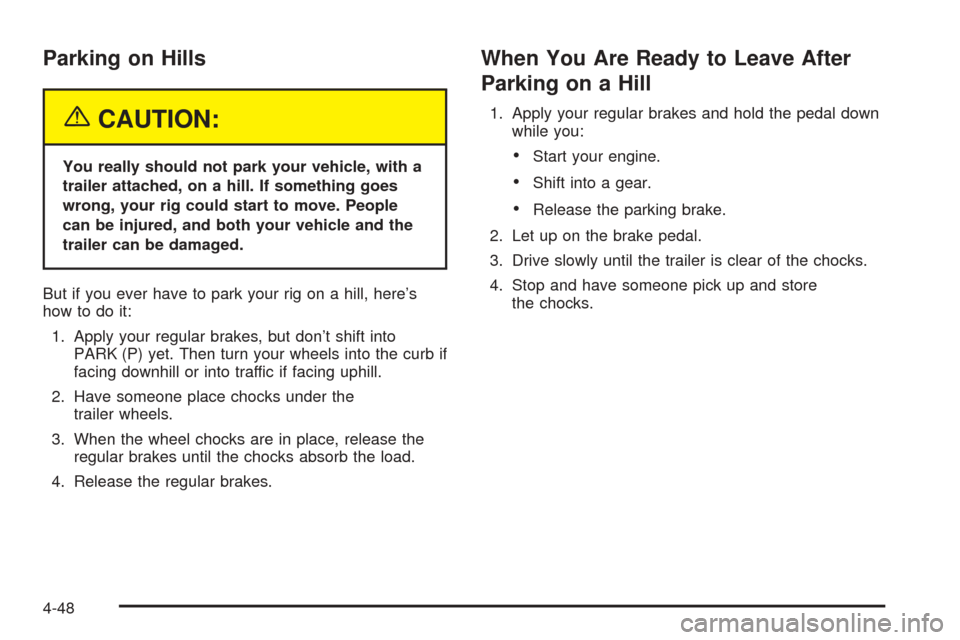
Parking on Hills
{CAUTION:
You really should not park your vehicle, with a
trailer attached, on a hill. If something goes
wrong, your rig could start to move. People
can be injured, and both your vehicle and the
trailer can be damaged.
But if you ever have to park your rig on a hill, here’s
how to do it:
1. Apply your regular brakes, but don’t shift into
PARK (P) yet. Then turn your wheels into the curb if
facing downhill or into traffic if facing uphill.
2. Have someone place chocks under the
trailer wheels.
3. When the wheel chocks are in place, release the
regular brakes until the chocks absorb the load.
4. Release the regular brakes.
When You Are Ready to Leave After
Parking on a Hill
1. Apply your regular brakes and hold the pedal down
while you:
Start your engine.
Shift into a gear.
Release the parking brake.
2. Let up on the brake pedal.
3. Drive slowly until the trailer is clear of the chocks.
4. Stop and have someone pick up and store
the chocks.
4-48
Page 245 of 374
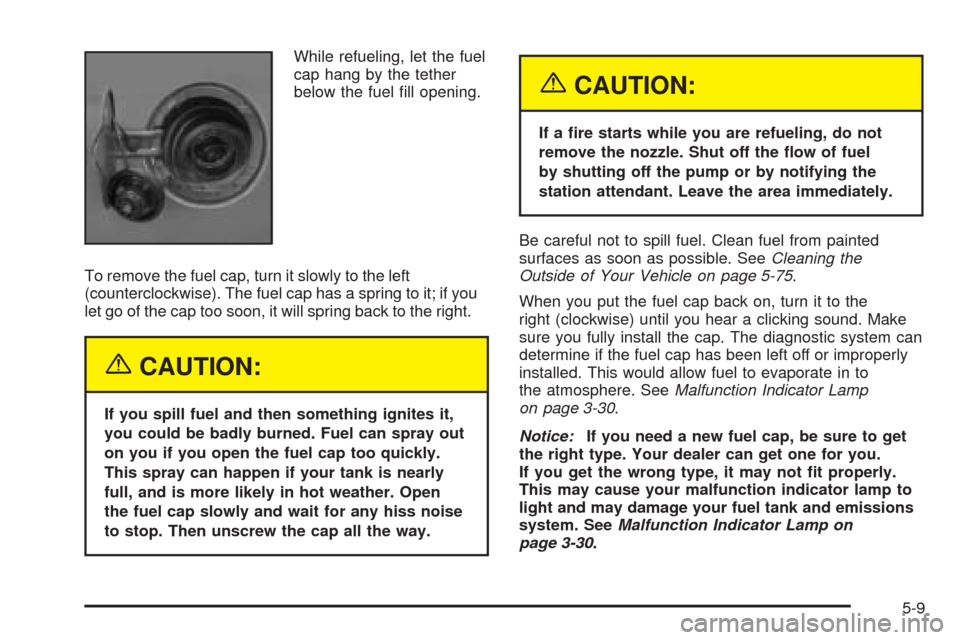
While refueling, let the fuel
cap hang by the tether
below the fuel �ll opening.
To remove the fuel cap, turn it slowly to the left
(counterclockwise). The fuel cap has a spring to it; if you
let go of the cap too soon, it will spring back to the right.
{CAUTION:
If you spill fuel and then something ignites it,
you could be badly burned. Fuel can spray out
on you if you open the fuel cap too quickly.
This spray can happen if your tank is nearly
full, and is more likely in hot weather. Open
the fuel cap slowly and wait for any hiss noise
to stop. Then unscrew the cap all the way.
{CAUTION:
If a �re starts while you are refueling, do not
remove the nozzle. Shut off the �ow of fuel
by shutting off the pump or by notifying the
station attendant. Leave the area immediately.
Be careful not to spill fuel. Clean fuel from painted
surfaces as soon as possible. SeeCleaning the
Outside of Your Vehicle on page 5-75.
When you put the fuel cap back on, turn it to the
right (clockwise) until you hear a clicking sound. Make
sure you fully install the cap. The diagnostic system can
determine if the fuel cap has been left off or improperly
installed. This would allow fuel to evaporate in to
the atmosphere. SeeMalfunction Indicator Lamp
on page 3-30.
Notice:If you need a new fuel cap, be sure to get
the right type. Your dealer can get one for you.
If you get the wrong type, it may not �t properly.
This may cause your malfunction indicator lamp to
light and may damage your fuel tank and emissions
system. SeeMalfunction Indicator Lamp on
page 3-30.
5-9
Page 253 of 374
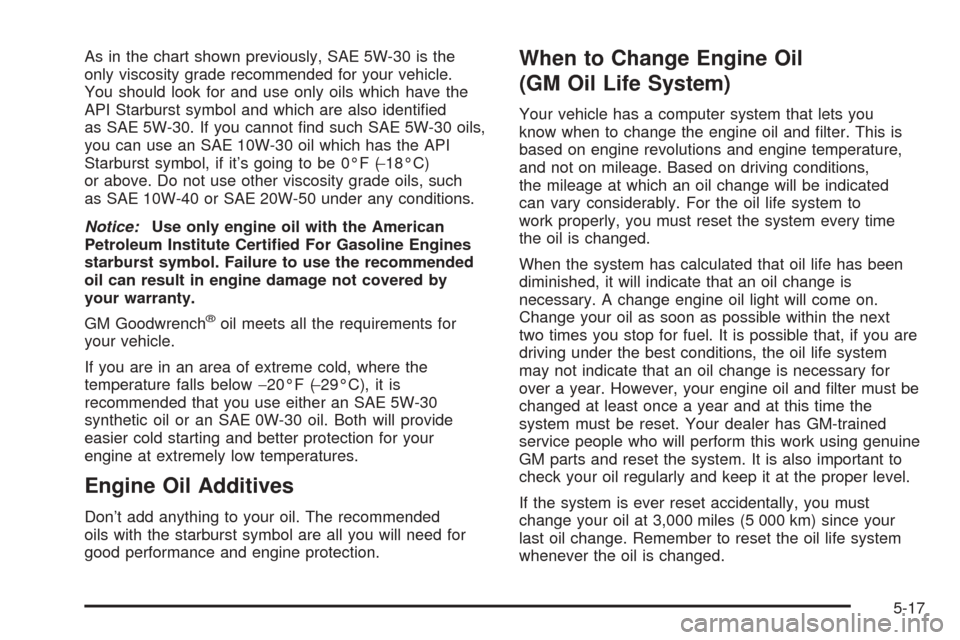
As in the chart shown previously, SAE 5W-30 is the
only viscosity grade recommended for your vehicle.
You should look for and use only oils which have the
API Starburst symbol and which are also identi�ed
as SAE 5W-30. If you cannot �nd such SAE 5W-30 oils,
you can use an SAE 10W-30 oil which has the API
Starburst symbol, if it’s going to be 0°F (−18°C)
or above. Do not use other viscosity grade oils, such
as SAE 10W-40 or SAE 20W-50 under any conditions.
Notice:Use only engine oil with the American
Petroleum Institute Certi�ed For Gasoline Engines
starburst symbol. Failure to use the recommended
oil can result in engine damage not covered by
your warranty.
GM Goodwrench
®oil meets all the requirements for
your vehicle.
If you are in an area of extreme cold, where the
temperature falls below−20°F (−29°C), it is
recommended that you use either an SAE 5W-30
synthetic oil or an SAE 0W-30 oil. Both will provide
easier cold starting and better protection for your
engine at extremely low temperatures.
Engine Oil Additives
Don’t add anything to your oil. The recommended
oils with the starburst symbol are all you will need for
good performance and engine protection.
When to Change Engine Oil
(GM Oil Life System)
Your vehicle has a computer system that lets you
know when to change the engine oil and �lter. This is
based on engine revolutions and engine temperature,
and not on mileage. Based on driving conditions,
the mileage at which an oil change will be indicated
can vary considerably. For the oil life system to
work properly, you must reset the system every time
the oil is changed.
When the system has calculated that oil life has been
diminished, it will indicate that an oil change is
necessary. A change engine oil light will come on.
Change your oil as soon as possible within the next
two times you stop for fuel. It is possible that, if you are
driving under the best conditions, the oil life system
may not indicate that an oil change is necessary for
over a year. However, your engine oil and �lter must be
changed at least once a year and at this time the
system must be reset. Your dealer has GM-trained
service people who will perform this work using genuine
GM parts and reset the system. It is also important to
check your oil regularly and keep it at the proper level.
If the system is ever reset accidentally, you must
change your oil at 3,000 miles (5 000 km) since your
last oil change. Remember to reset the oil life system
whenever the oil is changed.
5-17
Page 363 of 374
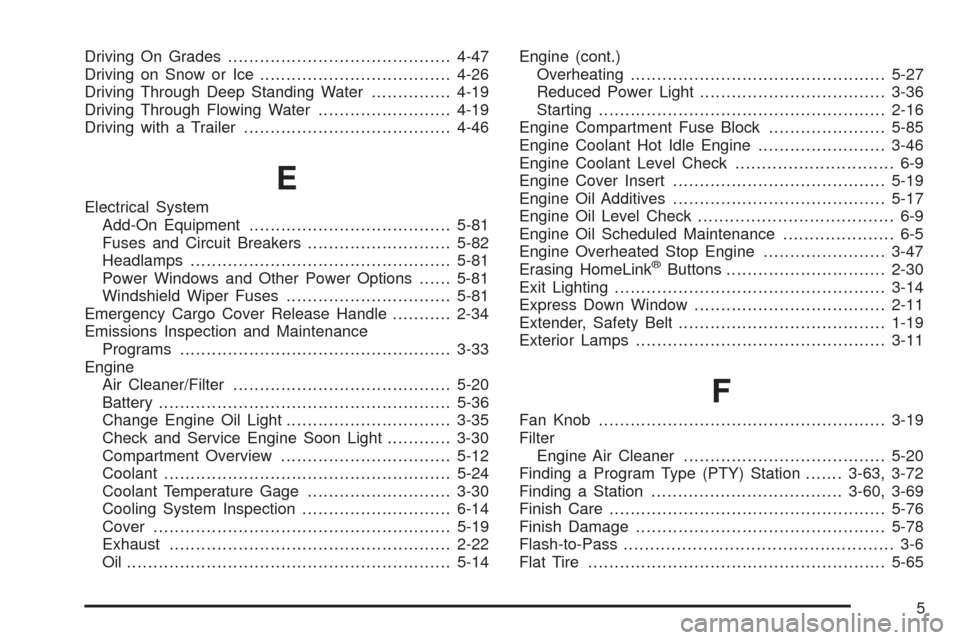
Driving On Grades..........................................4-47
Driving on Snow or Ice....................................4-26
Driving Through Deep Standing Water...............4-19
Driving Through Flowing Water.........................4-19
Driving with a Trailer.......................................4-46
E
Electrical System
Add-On Equipment......................................5-81
Fuses and Circuit Breakers...........................5-82
Headlamps.................................................5-81
Power Windows and Other Power Options......5-81
Windshield Wiper Fuses...............................5-81
Emergency Cargo Cover Release Handle...........2-34
Emissions Inspection and Maintenance
Programs...................................................3-33
Engine
Air Cleaner/Filter.........................................5-20
Battery.......................................................5-36
Change Engine Oil Light...............................3-35
Check and Service Engine Soon Light............3-30
Compartment Overview................................5-12
Coolant......................................................5-24
Coolant Temperature Gage...........................3-30
Cooling System Inspection............................6-14
Cover........................................................5-19
Exhaust.....................................................2-22
Oil .............................................................5-14Engine (cont.)
Overheating................................................5-27
Reduced Power Light...................................3-36
Starting......................................................2-16
Engine Compartment Fuse Block......................5-85
Engine Coolant Hot Idle Engine........................3-46
Engine Coolant Level Check.............................. 6-9
Engine Cover Insert........................................5-19
Engine Oil Additives........................................5-17
Engine Oil Level Check..................................... 6-9
Engine Oil Scheduled Maintenance..................... 6-5
Engine Overheated Stop Engine.......................3-47
Erasing HomeLink
®Buttons..............................2-30
Exit Lighting...................................................3-14
Express Down Window....................................2-11
Extender, Safety Belt.......................................1-19
Exterior Lamps...............................................3-11
F
Fan Knob......................................................3-19
Filter
Engine Air Cleaner......................................5-20
Finding a Program Type (PTY) Station.......3-63, 3-72
Finding a Station....................................3-60, 3-69
Finish Care....................................................5-76
Finish Damage...............................................5-78
Flash-to-Pass................................................... 3-6
Flat Tire........................................................5-65
5
Page 371 of 374
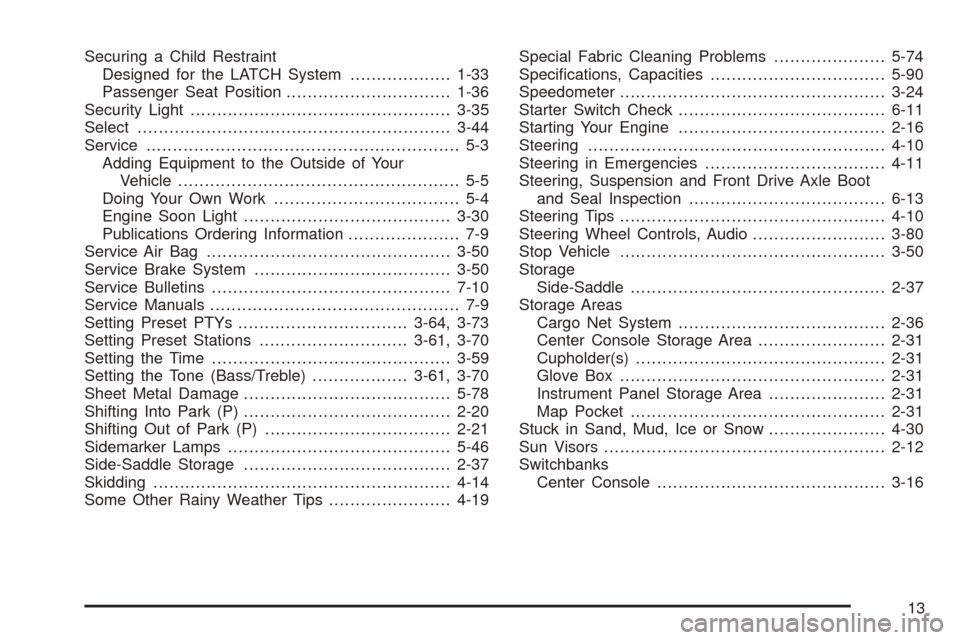
Securing a Child Restraint
Designed for the LATCH System...................1-33
Passenger Seat Position...............................1-36
Security Light.................................................3-35
Select...........................................................3-44
Service........................................................... 5-3
Adding Equipment to the Outside of Your
Vehicle..................................................... 5-5
Doing Your Own Work................................... 5-4
Engine Soon Light.......................................3-30
Publications Ordering Information..................... 7-9
Service Air Bag..............................................3-50
Service Brake System.....................................3-50
Service Bulletins.............................................7-10
Service Manuals............................................... 7-9
Setting Preset PTYs................................3-64, 3-73
Setting Preset Stations............................3-61, 3-70
Setting the Time.............................................3-59
Setting the Tone (Bass/Treble)..................3-61, 3-70
Sheet Metal Damage.......................................5-78
Shifting Into Park (P).......................................2-20
Shifting Out of Park (P)...................................2-21
Sidemarker Lamps..........................................5-46
Side-Saddle Storage.......................................2-37
Skidding........................................................4-14
Some Other Rainy Weather Tips.......................4-19Special Fabric Cleaning Problems.....................5-74
Speci�cations, Capacities.................................5-90
Speedometer..................................................3-24
Starter Switch Check.......................................6-11
Starting Your Engine.......................................2-16
Steering........................................................4-10
Steering in Emergencies..................................4-11
Steering, Suspension and Front Drive Axle Boot
and Seal Inspection.....................................6-13
Steering Tips..................................................4-10
Steering Wheel Controls, Audio.........................3-80
Stop Vehicle..................................................3-50
Storage
Side-Saddle................................................2-37
Storage Areas
Cargo Net System.......................................2-36
Center Console Storage Area........................2-31
Cupholder(s)...............................................2-31
Glove Box..................................................2-31
Instrument Panel Storage Area......................2-31
Map Pocket................................................2-31
Stuck in Sand, Mud, Ice or Snow......................4-30
Sun Visors.....................................................2-12
Switchbanks
Center Console...........................................3-16
13